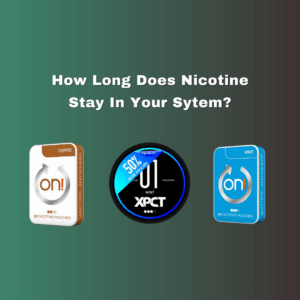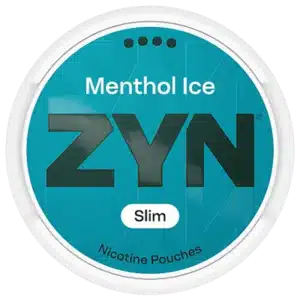How Long Does Nicotine Stay in Your System?
Introduction
Nicotine, commonly linked with smoking, is now widely used in other forms like nicotine pouches, vaping, and nicotine gum. Curious about how long nicotine stays in your system? You’re not alone. According to Statista, cigarette smoking among young adults in the U.S. dropped from 16% in 2011 to just 7% in 2023—highlighting the shift to smoke-free alternatives and the growing relevance of nicotine metabolism timelines.
Understanding detection windows is crucial for people undergoing workplace or medical screening, planning to quit, or simply curious about how long nicotine and its byproducts linger in the body. Whether you use ZYN, Velo Nicotine Pouches, White Gold Nicotine Pouches, or Rogue Nicotine Pouches, knowing the timeline helps you make informed decisions and plan accordingly.
How Long Does Nicotine Stay in Your System
Nicotine Metabolism Basics
Whether you’re using vaping devices, chewing nicotine gum, traditional snus, or modern nicotine pouches, nicotine enters your bloodstream within minutes. Once absorbed, it starts breaking down quickly—its half-life is just 1–2 hours, meaning half the nicotine is processed in that time. Still, that’s only the beginning of the story.
Read our guide: What Is a Nicotine Buzz
What is Cotinine
No matter the delivery method, the liver converts nicotine into cotinine, a much longer-lasting metabolite. Cotinine’s half-life is 15 to 40 hours, which is why it’s the go-to marker in tests.
-
Vaping: Delivers nicotine rapidly into the bloodstream, but it also introduces other chemicals from vaporized e-liquids.
-
Nicotine gum: Offers a slower release but can still keep cotinine levels measurable for several days.
-
Snus: Traditional smokeless tobacco comes with not just nicotine, but also unwanted byproducts from tobacco leaf processing.
-
Nicotine pouches: Deliver nicotine without tobacco leaf content, often seen as a cleaner alternative compared to snus and vaping, while still following the same cotinine conversion process.
Why Cotinine Matters
Testing programs don’t look for nicotine itself—they look for cotinine. That’s because cotinine lingers in urine, blood, saliva, and hair long after the last use. Regardless of whether you vape, chew gum, use snus, or place a pouch under your lip, cotinine is what shows up in labs. For many, this makes pouches a more predictable choice, since they provide nicotine without the added byproducts found in other delivery methods.
Read our guide: Is ZYN Snus
How Long for Nicotine to Leave System
| Test Type | Nicotine Detection | Cotinine Detection | Typical Duration for Occasional Use | Typical Duration for Frequent Use |
| Blood | Up to ~3 days | Up to ~10 days | ~2–3 days | Up to ~10 days |
| Urine | ~3–4 days | Up to ~21 days | ~5–10 days | Up to ~3 weeks |
| Saliva | ~1–3 days | Up to ~7 days | ~3–5 days | Up to ~7 days |
| Hair | — | Up to ~90 days | ~30 days | Up to ~90 days or longer |
How to Get Nicotine Out of Your System
Hydration and Kidney Support
Drinking plenty of water helps flush cotinine out via urine. Staying hydrated speeds up elimination and can slightly shorten detection windows.
Supporting Metabolism Through Diet
Fruits, vegetables, and fiber-rich foods can support liver and kidney function. Some people try detox teas or antioxidant supplements, although scientific validation is limited. A healthy diet can help the body process compounds more efficiently.
Physical Activity
Exercise increases blood flow and metabolism, supporting quicker clearance of metabolites like cotinine. Combine cardio and strength training to maximize the effect.
How to Flush Nicotine Out of Your System
Here’s a practical, step-by-step guide:
- Cease all nicotine intake, including pouches, vaping, and gum.
- Drink 8–12 glasses of water daily to support kidney filtration.
- Exercise regularly—aim for at least 30 minutes of activity each day.
- Eat a balanced diet rich in fiber, antioxidants, and whole foods.
- Consider light sauna or sweating (if medically safe) to promote detox via sweat.
- Track your quitting/detox timeline with a journal to notice changes over time.
Lifestyle and Popular Nicotine Products
Nicotine Pouches in the Market
Products like ZYN, Velo Nicotine Pouches, White Gold Nicotine Pouches, and Rogue Nicotine Pouches are popular due to ease of use and range of ZYN Flavors, particularly ZYN Black Cherry. While convenient, regular use—flavored or not—extends cotinine detection times in line with what we’ve discussed.
Read our article: Black Cherry ZYN – What Is The Hype
Vaping and Nicotine Gum
Though delivery modes differ (inhalation vs. buccal absorption), the body treats nicotine from vaping or gum the same at a metabolic level. Both convert to cotinine and clear on similar timelines.
Read our guide: Are ZYNs Better Than Vaping? – (Which they are indeed)
Read our guide: Nicotine Gum VS Pouches
Zyn Rewards and Usage Behavior
Programs like Zyn Rewards encourage frequent purchases—and often frequent use. Increased consistency of intake prolongs cotinine presence, making detection more likely if timing matters for testing or personal goals.
Conclusion
Understanding how long nicotine stays in your system is far more than a metabolic curiosity—it’s vital for planning, quitting, or preparing for tests. While nicotine disappears within hours, cotinine can be detected for days to weeks, depending on your usage patterns and test type. Urine, blood, and saliva detection windows range from a few days to a few weeks, and hair testing can extend detection to several months.
Whether you use flavored pouches, vapes, or chew nicotine gum, the metabolic timeline remains consistent: nicotine → cotinine → elimination. Stopping use, hydrating, eating well, and exercising all help minimize how long metabolites remain detectable.






